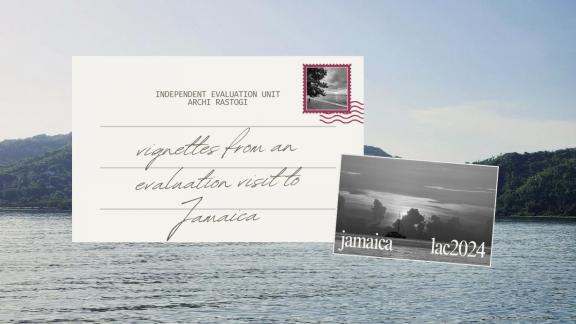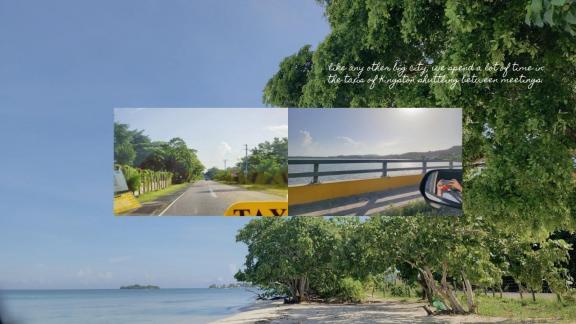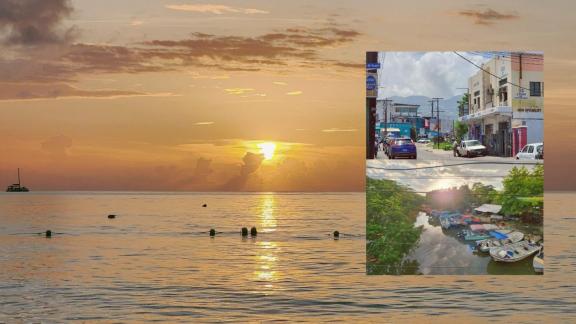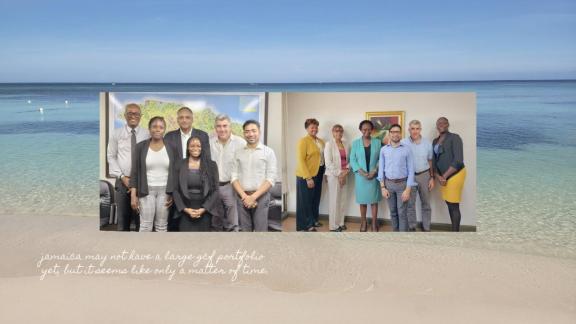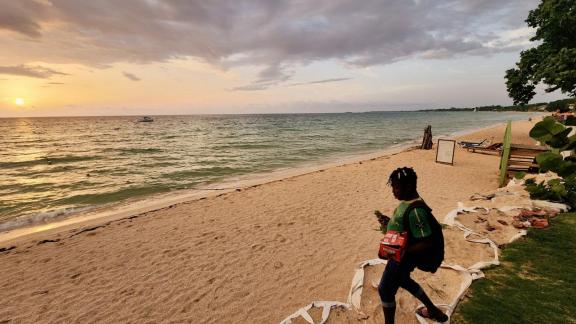A postcard from the Caribbean
Vignettes from an evaluation visit to Jamaica
I grew up very far from the coast, and saw the ocean for the first time only as an adult. The blue of the ocean still shocks me every time I see it. And here I am in Jamaica. Jamaica is one of the five country case studies for the ongoing the IEU evaluation of the GCF portfolio in Latin America and the Caribbean and I am undertaking the case study with Santiago Soler, a senior expert specializing in the region.
Before we set off to the country, we are quite baffled by a strange paradox in Jamaica. The country has relatively high development and economic indicators. It has a vibrant private sector, and it scores well on governance indices. Jamaica is engaged with the GCF, but only through readiness and some multi-country projects. Why then does it not have a larger portfolio with the GCF? We arrive with the hope to find some answers.
Covid still haunts
Patrick [name changed] drives me from the airport to the hotel. Patrick is not a man of many words, but is quite chip. He points me to various features along the road to the hotel, a veritable list of all-inclusive resorts. I follow my habit of familiarizing myself with a new place; I start asking Patrick about the status of tourism and he is happy to chat along. There are a lot of tourists, mostly American and Canadian, and there is a lot of dependence on tourism, says Patrick. A large share of tourism goes to large all-inclusive resorts, and Patrick thinks there is limited trickle down of the revenue. Yet, Patrick is very supportive of tourism.
Indeed, I am aware tourism is one of the largest contributors to Jamaican GDP. But then, a tourism-based economy in an island must have been hard hit by Covid? Patrick becomes quiet at the mention of Covid. “Covid was hard. Very hard”, he says as he stares into the distance. I don’t know if Patrick owns the car he is driving or whether he has alternative sources of income. I wonder what he might have done to overcome Covid. I don’t bring it up again.
Mango season
Like any other big city, we spend a lot of time in the taxis of Kingston shuttling between meetings. The heat is oppressive, and our schedule is a bit tight, so taxis are a blessing. The go-to music in taxis is generally reggae. When the radio plays the national news, one of the key news is about saltwater intrusion of irrigation water.
The traffic in Kingston is severe, and for a combination of reasons: this was pay week, people are buying groceries, and Hurricane Beryl is expected next week (the hurricane struck the following week and went on to leave 400,000 people without power). So, roads in Kingston are clogged in anticipation. It is also the summer season. There is a large mango tree on the premises of the NDA office. Its mangoes are the size of small coconuts. The slightest storm makes them fall on the unsuspecting cars parked underneath. Sure, these large mangos are excellent for chutneys, but the NDA staff colleagues are not amused by dents on their cars.
The debt story
The government offices themselves are austere buildings. Mostly painted in Caribbean blues, they are not ostentatious in the way that many government buildings can be. My own theory is that this has to do with the relative austerity of the government. While the country has high income overall, it is also a case study for macroeconomic policies.
Jamaica became independent in 1962 and its economy has seen several highs and lows. In the 1970s and 1980s, economic policies such as nationalization and increased public spending led to significant borrowing. Structural adjustment programs in the 1980s and 1990s, though necessary for fiscal stability, often involved taking on new loans, adding to its extraordinary debt burden. The relatively small and open economy was always vulnerable to external shocks, whether fluctuations in global commodity prices or natural disasters, all of which continued to add to debt stress.
And the story of public debt has been remarkable in Jamaica. The debt to GDP ratio has been a longstanding issue; the debt of Jamaica was as high as 144 per cent of GDP at the end of 2012. Over time, the government undertook resolute policy actions and brought the debt ratio down (despite the low average annual real growth) to 72 per cent in 2023, with expectation that this will reduce further and very quickly so. This remarkable achievement was made possible by strong and determined fiscal rules, which are the subject of many academic studies (for instance, refer to this study).
The ripples of this fiscal discipline are seen even in development finance and climate finance. Because a large part of the government revenue is allocated to servicing debt, only limiting funds are available for development projects and social services. There seems to be reluctance to take on even concessional debt. More so, Jamaica is an upper middle-income country, not eligible for IDA-only terms but IBRD-only terms for development assistance. This means that there is relatively limited development assistance, and much of this already-limited portfolio is directed towards other equally pressing challenges, and less so on climate. This makes the GCF even more relevant – while domestic resources are focused on social issues, can the GCF finance provide the safety against climate change? (What type of GCF financial instruments could be potentially useful for such a context? Read the IEU’s latest work here.)
Pride and prejudice
When Jamaica comes up, it is easy to make a mental association with rasta and reggae, and balmy beaches (and formerly bauxite). This may be to the credit of the tourism sector in Jamaica. But this image of an easygoing and relaxed culture belies a matrix of underlying social issues and a sense of immense national pride. For example, Jamaica is an unwitting party to a trade. It is the first land mass on the route from south America to north America. This fortuitous spot also means that the country is a stopover for any illegal trade between diverse geographies. Weapons and drugs are acknowledged issues, leading to related issues with crime and lack of education.
Such social issues are offset by a national culture of dialogue, social partnership, and consensus-building. The credit for addressing issues of debt also goes to a universal culture of consensus-building. For more than 40 years, the country has had bipartisan support for independent and nonpartisan institutions like the Electoral Advisory Committee on electoral standards, and National Planning Council for planning. Similarly, the Economic Programme Oversight Committee came about ten years ago, to handle fiscal adjustment and debt sustainability. Within this context of strong institutions, climate finance is supported by strong national institutions as well. Two such institutions are already accredited: the Jamaica Development Bank and the Jamaica Social Innovation Fund. Between them, they already cover the national development bank and a fund that reaches virtually every community with cross-sectoral projects. Oversight is provided by various insitutions, including the Planning Institute of Jamaica, which oversees relations with various development partners. With more institutions on the way to accreditation, and generally a high interest in the GCF and concessional climate finance, it is a matter of time that Jamaica should have a thriving portfolio with the GCF. Jamaica is still the paradox to me – high capacity and low access, perhaps proving the point that there are diverse climate pathways.
By the end of my visit, I have my answer. Jamaica may not have a large GCF portfolio yet, but it seems like only a matter of time. The country has long had the institutions and the capacity to develop GCF projects. With its patient development of the GCF pipeline, I leave with the certainty that a similar case study in five or ten years will look at a very different portfolio in Jamaica.
Disclaimer: The views expressed in blogs are the author's own and do not necessarily reflect the views of the Independent Evaluation Unit of the Green Climate Fund.

